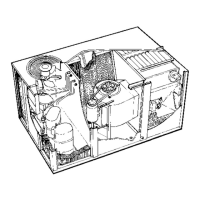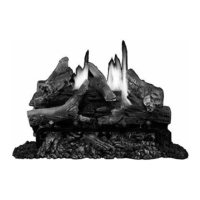Page 73
C1 DIAGRAM WITH B41 and A8 DIAGRAMS
Electromechanical Thermostat Connected to GCS16-2553, -2753 or -3003 with 235,000 BTUH Input Heat (Without Economizer)
E-GCS16-2553235, GCS162753235 or GCS163003235
Operation Sequence: C1 and B9 and A8 Sections (electromechanical thermostat
wired to GCS16)
The GCS162553 and CHA162553 and larger units use two compressors and two inde
pendent cooling circuits. However, each evaporator slab is split circuited effectively plac
ing two evaporators and two expansion valves on each cooling circuit (four expansion
valves per unit).
A pilot relay board is factory installed in all models of this size range. The board is used to
reduce contactor chattering caused by long runs of undersized thermostat wire. The relays
on the pilot relay board have a comparatively smaller inrush than the contactors they serve
thereby reducing the potential for contactor chattering.
All models of this size range use a modular" heating section which may be easily changed in
the factory to larger or smaller BTUH input sizes. Each different heat section is represented
by a unique heating section wiring diagram which mates to the unit diagram as shown on the
facing page (diagram A8). Different wiring diagrams are used to represent the different
BTUH input sections. The 235,000 BTUH version is shown here.
In the 2553, 2753 and 3003 models, the condenser fans operate independently. Dur
ing normal operation, one fan operates during first stage demand and both fans operate
during second stage demand.
Power:
1- When the unit disconnect closes, line voltage energizes transformer T1 and the com
pressor crankcase heaters. Transformer T1 provides 24VAC power to most unit cool
ing, heating and blower controls and thermostat. The crankcase heaters are powered
at all times but are selfregulating
2- Transformer T18 provides 24VAC power to the unit contactors
3- Transformer T3 (460V and 575V units) is also energized when power is applied to the
unit.
4- Transformer T10 (units equipped with power exhaust fans) is also energized when power
is applied to the unit.
Cooling Demand:
5- On a call for first stage cooling (Y1), demand is routed through DL8 (30 second on delay, 240
second off delay) and the first stage safety limits to energize pilot relay K66.
6- At the same time, the indoor thermostat energizes the indoor blower circuit (G). Blower
demand energizes pilot relay K46.
7- When K661 closes, a 24VAC circuit is completed to energize contactors K1 and K127.
Both contactors immediately switch. K127 closes to energize K10 and K68.
8- When K461 closes, a 24VAC circuit is completed through blower relays K20 and K25 to
energize indoor blower contactor K3 and optional economizer (which opens the outdoor
air dampers to minimum position).
9- When contacts K31 close, the indoor blower is energized immediately and begins oper
ating.
10- When contacts K101 and K681 close, condenser fan B4 and B5 are energized and
immediately begins operating.
11- When contacts K1-1 close, comrpressor B1 is energized and immediately begins op
erating.
12- On a call for increased cooling (Y2), pilot relay K67 is energized after DL9 completes a 30 sec
ond on delay.
13- When K671 closes, a 24VAC circuit is completed through the second stage safety limits to en
ergize contactor K14. K14 immediately switches.
14- When contacts K141 close, compressor B13 is energized and immediately begins operat
ing.
Heating Demand:
15- On a call for first stage heating (W1), pilot relay K77 is energized.
16- When K771 closes, a 24VAC circuit is completed into the heating section to energize com
bustion air blower relay K13.
17- When contacts K131 close, combustion air blower B6 is energized and immediately be
gins operating. When contactst K132 close, the gas valve is enabled.
18- As the combustion air blower approaches full speed, combustion air blower prove switch
(S18) closes.
19- When S18 closes a 24VAC circuit is completed through the heating safety switches to en
ergize burner ignition control A3.
20- When ignition control A3 determines that ignition can begin, A3 simultaneously sends 24VAC to
the first stage operator of the gas valve and to the indoor blower delay relay (K25) and also
sends spark to the spark electrode. The gas valve immediately opens and blower delay K25
immediately begins timing.
21- When flame is sensed by the ignition control, spark is stopped and the gas valve remains
open. If flame is not sensed within the time allowed, spark is stopped, the gas valve is
closed and the ignition control begins its retrial timing sequence.
22- When blower delay K25 ends its timing period, K251 switches. A 24VAC circuit is com
pleted through K201 to energize blower contactor K3 and optional economizer (which
opens the outdoor air dampers to minimum position).
23- When contacts K31 close, the indoor blower is energized immediately begins operat
ing.
24- On a call for increased heating (W2), pilot relay K49 is energized.
25- When K491 closes, a 24VAC circuit is completed into the heating compartment to ener
gize time delay DL3. DL3 immediately begins its timing sequence.
26- When DL3 time delay has elapsed, DL3 closes internally to complete a circuit to energize the
second stage heat pilot relay K19.
27- When K191 closes, a 24VAC circuit is completed to the second stage operator of the gas
valve (W2). When gas valve operator W2 is energized, the gas valve begins to slowly open
for second stage operation.
28- If either heating limit S10 or S21 open during heating operation, ignition control A3 is imme
diately deenergized and blower limit relay K20 is immediately energized.
29- When A3 is deenergized, the gas valve (W1) and blower delay (K25) are both deen
ergized.
30- When K201 switches, blower contactor K3 is energized to continue blower operation during
the time that safety limits are open.
31- When gas valve (W1) is deenergized, it prevents second stage gas valve (W2) from
operating.

